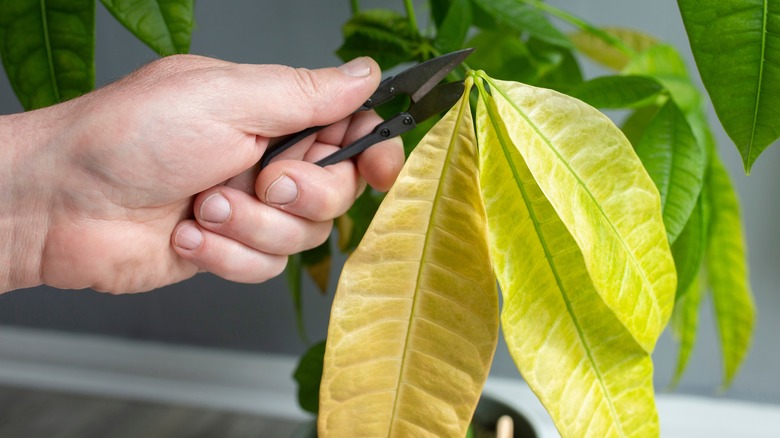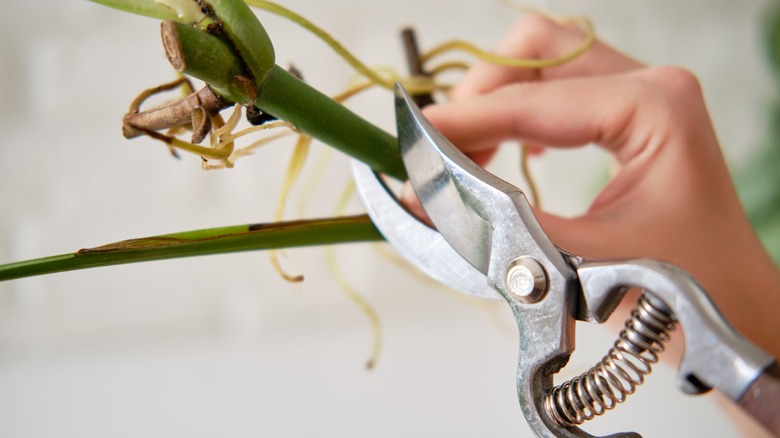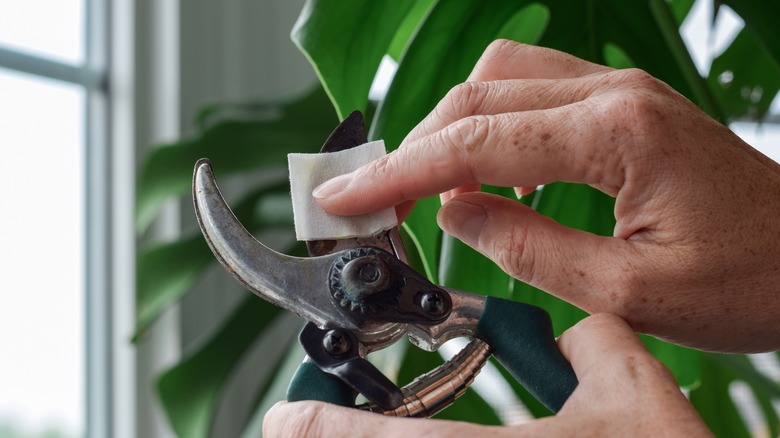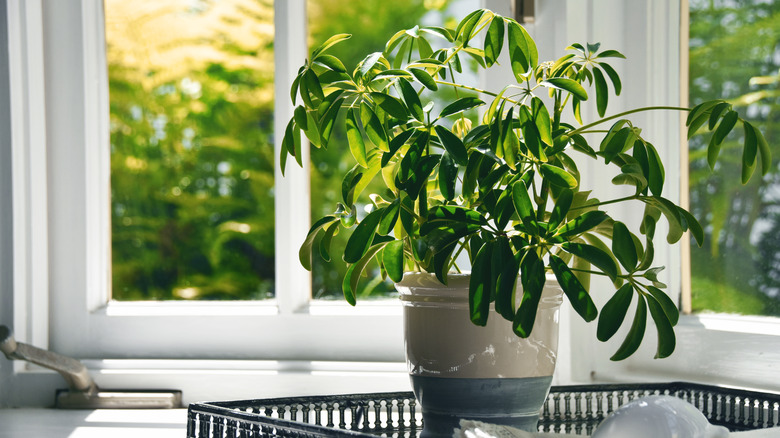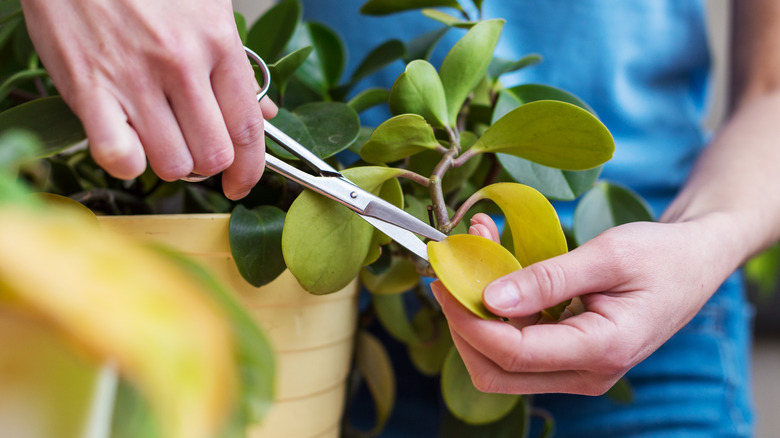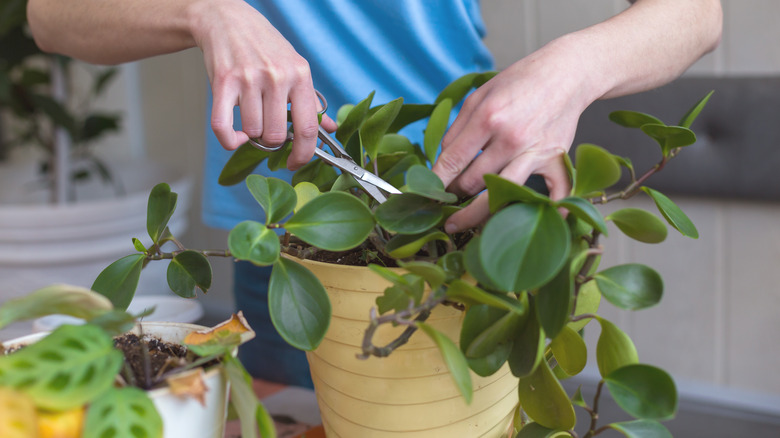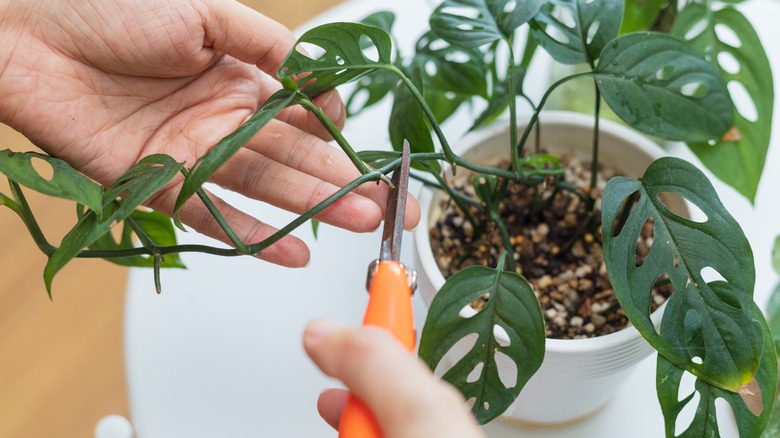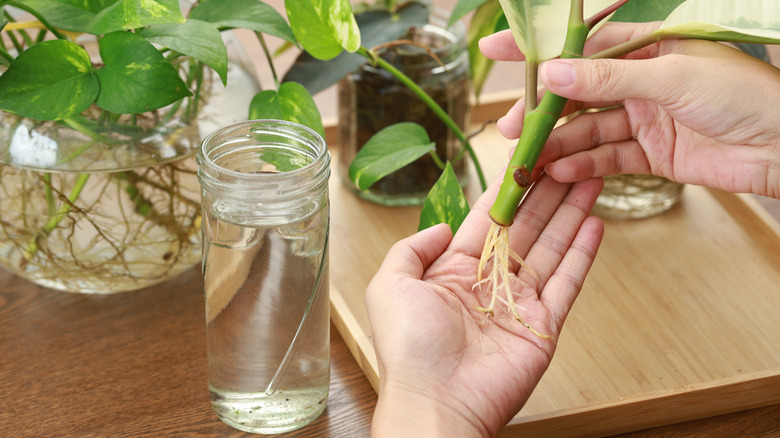Beginner Gardening Tips To Prune Your Houseplants Like The Pros
When you think of pruning, you may think of outdoor gardens with lush shrubbery. However, cutting away dead or unwanted growth isn't reserved for the backyard, and most houseplants greatly benefit from regular haircuts. These living green beauties have minds of their own and can get unruly without maintenance. Thinning out your plants allows you to keep them looking great and even helps promote new, healthy growth. Despite the benefits, chopping off stems for the first time can feel like a daunting task.
You don't want to grab a pair of scissors and go to town. Without a strategy, you could easily make a regrettable snip or make an avoidable mistake. Cutting off the wrong parts of plants can cause undesired growth in the wrong direction. Even worse, not having the right tools and technique can create unnecessary risks like spreading diseases or damaging the fragile leaves and stems. Luckily, with a few simple gardening tips, you can prune houseplants like a pro.
Make a plan before pruning
If you trim too much, you can't undo it. So, it's best to have a plan in mind. Consider what your goal is before making any cuts. Are you removing diseased areas? Trying to promote growth? Once you have a general idea of your direction, eyeball your plant to determine which areas you want to prune. Use a marker like a Post-it note colored tape near the leaves or branches you intend to remove. Doing so lets you step back, visualize the end result, and make any adjustments before taking action.
Removing too much of a houseplant at once may cause it to go into shock, so you don't want to go overboard during your pruning sessions. Plants make their food through photosynthesis by soaking up the sun through their leaves. By taking too many energy-providing leaves away, your plant could starve. Over-pruning may result in stunted growth, which is usually the opposite of the desired intention.
Use the right tools for your specific houseplant
When it's time to give your plant a haircut, you want to ensure you have the right tools for the job. There are several pruners on the market to choose from. Opt for heavy-duty anvil or ratchet pruning shears for thick, woody varieties. If you have houseplants that require fine cuts, straight blade pruners are a thinner option and easier to maneuver. Not every plant requires fancy tools, however. A pair of kitchen scissors can do the trick for houseplants with thinner leaves or stems, like snake plants or pothos.
In any case, only cut plants with sharp blades to get precise, clean cuts. Using dull pruners is more difficult and usually results in crushing the stems or leaving behind jagged edges. Clean cuts heal more easily and pose less of a risk of developing diseases. Luckily, a high-quality pair of shears should last for years to come. Some companies even sell replacement blades, so you won't need to buy a new tool altogether.
Only use clean tools when cutting
Not only do you want sharp tools, but sanitizing them is equally, if not more, important. Clean your tools each time you plan to cut your houseplants. You can purchase several specialized cleaning products, though rubbing alcohol will do the trick. Apply some 70% isopropyl alcohol to a cloth and wipe the entire pruner thoroughly. You'll also want to give them a deep clean at least once a year. To do so, take apart your gardening shears and closely examine where all the pieces will go back together so you don't forget. You may also refer to any instructions you received with the tool. Not all pruners are detachable, so you can skip this step if that's the case. Scrub all the parts with hot, soapy water. Wipe everything and ensure it is completely dried. If there are any rusty spots, use steel wool to remove them. Once you're finished, reassemble your shears. Finish by oiling or lubricating your pruners to keep them in great operational order.
While it may be tempting to skip the cleaning routine here and there, doing so is crucial to keeping your plants happy and healthy. Like with a scratch on a human, an open wound is susceptible to getting an infection. If another houseplant has a disease, it could transfer to your shears. Then, unknowingly, you could spread it to the rest of your plants.
Primarily prune during the growing season
While there are several motives for thinning out your plants, pruning to encourage growth, maintaining its shape, or managing unruly foliage should be done in the growing season. As the phrase suggests, this is the time of year your plants show the most growth, typically in the spring or summer. Once you determine your varieties' growing season, you can begin removing unwanted sections. Cut at a 45-degree angle, being careful not to remove too much at once. Focus on leggy areas to promote fuller regrowth. To encourage blooming, cut off any dead or dying flowers.
Pruning is one of the best ways to keep your plant development on track. Plus, doing so gives you more control over how your indoor garden looks. However, you should only prune when a plant is actively growing. Cutting off stems during more dormant months makes it harder for your plants to produce new growth and recover. However, small fixes like removing a leggy vine are fine to do periodically during their resting phase.
Remove any yellow or damaged leaves when they appear
Unlike yearly pruning, you should remove any damaged leaves when they pop up. Yellow and brown leaves lack chlorophyll (the pigment that makes the plant green) and no longer provide nutrients for the plant. Plus, they can look unsightly against the healthy foliage. However, don't worry about leaves with a spot of discoloration; if it's mostly green, it can still photosynthesize. Use sharp scissors or gardening shears and chop them off near the stem. You can even get away with pinching brown and shrunken leaves off, but only use your fingers if the leaf detaches easily.
Although cutting off damaged areas allows your plant to focus on providing nutrients to healthy leaves, it likely won't solve all your problems. Frequent appearances of yellow or brown leaves are your houseplant's way of telling you something is wrong. If your plant is yellowing toward the top, especially towards a window, this signifies it's due to receiving too much sun. Lower yellow leaves tend to indicate watering issues. If your houseplant continues to have yellowing or brown leaves or the damaged leaves are taking over your plant, it could be due to pests or diseases.
Don't remove more than 30% of the plant
Only remove 10-30% of the leaves every couple of months at most. This is especially important if your houseplant doesn't have a healthy root system. Losing a good chunk of leaves could cause your plant to go into shock. Instead, focus on the parts of the plant that truly require pruning. For vining plants, like pothos, cut back about 6 inches. Wait for blooming species to flower; you could kill off healthy buds that would otherwise provide beautiful blooms.
The one exception to the rule occurs with dying plants. Houseplants with a pest infestation, root rot, or other diseases will likely not survive even if you eliminate the damaged sections. Instead, your best bet to start anew is to "chop and prop" or propagate everything that's undamaged. Rather than removing the dead and unsightly leaves and stems, only cut off healthy parts. Throw away the soil, roots, and any of the damaged leftovers to avoid infecting other plants.
Cut your plants in the correct spot
The location you cut your plants depends on your reason for doing so. If you have a leggy plant you want to bring back to life, cut right above the leaf node. This will encourage new and fuller growth and give your plant a much nicer look. For flowering plants, routinely check for dead flowers that are limp, discolored, or dry to the touch. Use gardening shears to snip them off at the flower head's base. To remove entire stalks on thicker plants, get as close to the main stem as possible.
While chopping off sections of your plants may make them look better in the moment, a wrong cut can defeat the purpose. Knowing where your plant puts out new growth makes knowing the right cut a lot easier. For example, some plants have leaf nodes on differing sides, so you can control which direction it continues to grow depending on where you snip. Plus, since the growth happens from the node, leaving the excess stem behind keeps it looking leggy and uses up unnecessary energy.
Propagate healthy plant parts
After trimming back an unruly plant, consider propagating pieces with healthy leaves and stems. Most plants require a leaf node to propagate successfully, so cut sections around them. If placing in water, remove any submerged leaves to avoid rotting. Other species, like snake plants, can grow from the leaves themselves. Cut close to the soil, and cover the bottom with about 25% water. Don't forget to change your water regularly to ensure healthy growth.
There aren't any negatives to propagating leftover plants. If you want the mother plant to look fuller, place the cuttings back in the soil once they root. Or, enjoy growing beautiful new plants over and over again. Not only are you creating more stunning greenery, but you'll also have free gifts to give plant-loving friends and family. You can also sell extra plants on sites like Facebook Marketplace or Etsy. Because your plant will continue to grow and need pruning, you can make some decent side cash if you want to.

